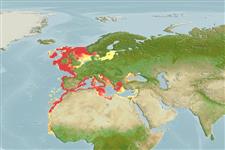Environment: milieu / climate zone / depth range / distribution range
Écologie
marin démersal; profondeur 40 - 700 m (Ref. 56504). Subtropical; 62°N - 10°N, 18°W - 36°E
Eastern Atlantic: western Norway, Skagerrak, Shetlands and western Scotland to Senegal. Also in the Mediterranean (mainly western part).
Length at first maturity / Taille / Poids / Âge
Maturity: Lm 8.2 range ? - ? cm
Max length : 30.0 cm TL mâle / non sexé; (Ref. 5377); common length : 13.0 cm SL mâle / non sexé; (Ref. 4952)
Épines dorsales (Total): 9 - 10; Rayons mous dorsaux (Total): 23-25; Épines anales 3; Rayons mous anaux: 22 - 24. Eye large; snout as long as eye or longer. Mouth very protractile, forming a short tube when protruded. Third dorsal and anal spines only a little longer and stronger than the others. Body depth more than one and a half times in standard length. Vertebrae 21-23.
Depth range from 40-600 m (Ref. 35388) and from 288-700 m in the eastern Ionian Sea (Ref. 56504). Gregarious. Form schools. Found over rock or coral, but also trawled over sandy ground. Feed on crustaceans or worms, mollusks (Ref. 4952). Males are smaller than females (Ref. 5377).
Quéro, J.-C., 1986. Caproidae. p. 777-779. In P.J.P. Whitehead, M.-L. Bauchot, J.-C. Hureau, J. Nielsen and E. Tortonese (eds.) Fishes of the north-eastern Atlantic and the Mediterranean. UNESCO, Paris. Vol. 2. (Ref. 4952)
Statut dans la liste rouge de l'IUCN (Ref. 130435)
Menace pour l'homme
Harmless
Utilisations par l'homme
Pêcheries: sans intérêt
Plus d'informations
RéférencesAquacultureProfil d'aquacultureSouchesGénétiqueElectrophoresesHéritabilitéPathologiesTraitementNutrientsMass conversion
Outils
Articles particuliers
Télécharger en XML
Sources Internet
Estimates based on models
Preferred temperature (Ref.
123201): 6.9 - 15, mean 10.7 °C (based on 295 cells).
Phylogenetic diversity index (Ref.
82804): PD
50 = 1.0000 [Uniqueness, from 0.5 = low to 2.0 = high].
Bayesian length-weight: a=0.01905 (0.01455 - 0.02496), b=2.81 (2.73 - 2.89), in cm total length, based on LWR estimates for this species (Ref.
93245).
Niveau trophique (Ref.
69278): 3.1 ±0.3 se; based on diet studies.
Résilience (Ref.
120179): Faible, temps minimum de doublement de population : 4,5 à 14 années (K=0.145; tmax=26; tm=1.84).
Prior r = 0.44, 95% CL = 0.29 - 0.69, Based on 1 stock assessment.
Fishing Vulnerability (Ref.
59153): Low to moderate vulnerability (30 of 100).
Climate Vulnerability (Ref.
125649): Low vulnerability (19 of 100).
Nutrients (Ref.
124155): Calcium = 74.7 [37.7, 139.1] mg/100g; Iron = 1.11 [0.56, 2.07] mg/100g; Protein = 17.9 [16.7, 19.0] %; Omega3 = 0.313 [0.180, 0.549] g/100g; Selenium = 37 [16, 86] μg/100g; VitaminA = 18.1 [4.5, 77.6] μg/100g; Zinc = 0.767 [0.502, 1.164] mg/100g (wet weight);
